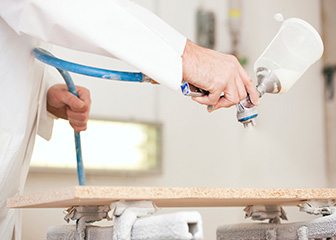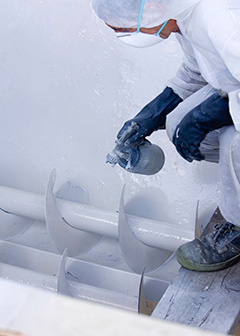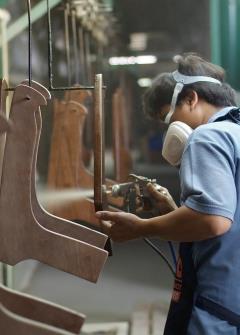Painting, Coating, and Decorating Workers
Does this career fit your work personality?
Begin The Career Assessment Test- Best Fitting Careers
- Work Personality Strengths
- Work Style Preferences
- and more
Job Outlook
Overall employment of painting and coating workers is projected to show little or no change from 2022 to 2032.
Despite limited employment growth, about 16,700 openings for painting and coating workers are projected each year, on average, over the decade. Most of those openings are expected to result from the need to replace workers who transfer to different occupations or exit the labor force, such as to retire.
Education Details
Summary of What they do:
Paint, coat, or decorate articles, such as furniture, glass, plateware, pottery, jewelry, toys, books, or leather.
What Painting and Coating Workers Do
Painting and coating workers apply finishes, often using machines, to products such as cars, jewelry, and ceramics.
Duties

Painting and coating workers typically do the following:
- Set up and operate machines that paint or coat products
- Select the paint or coating needed for the job
- Clean and prepare products to be painted or coated
- Determine the required flow of paint and the quality of the coating
- Apply paint or coating
- Measure the thickness of paint or coating material applied
- Clean and maintain tools, equipment, and work areas
Painting and coating workers apply paint, varnish, rustproofing, or other types of liquid treatments to finish and protect products. They often use machines to spread the liquid over large surfaces but may use handtools on small items or hard-to-reach surfaces.
Before workers apply the paint or other coating, they prepare the surface by sanding or cleaning it to prevent dust from becoming trapped under the paint. They also may cover portions of the product with tape and paper to prevent the paint or coating from touching those areas.
After the product is prepared, workers may use a number of techniques to apply the paint or coating. Common techniques include spraying products with paint or coating and dipping items in a large vat of paint or other coating. Many factories use automated painting systems. Workers may measure the paint thickness using a coating thickness gauge or painter meter.
The following are examples of types of painting and coating workers:
Coating, painting, and spraying machine setters, operators, and tenders use spraying or rolling machines to apply lacquer, enamel, or other coatings to a variety of products, such as cars, boats, and glassware. These workers position the spray guns, set the nozzles, and synchronize the action of the guns with the speed of the conveyor carrying products through the machine. During the process, they program the machine, tend the equipment, watch gauges on the control panel, and check products to ensure that they are being painted evenly. The operator may use a manual spray gun to touch up flaws.
Painting, coating, and decorating workers use manual spray guns, pens, or brushes to apply various coatings to furniture, glass, pottery, toys, books, and other products. They also may immerse pieces into the liquid and place the coated items into ovens or dryers to harden the finishes. In addition, these workers examine products to be sure that they meet specifications.
For information about workers who paint walls, equipment, buildings, bridges, and other structures, see the profile on construction and maintenance painters.
Important Qualities
Artistic ability. Some painting and coating workers make elaborate or decorative designs.
Color vision. Workers must be able to blend new paint colors in order to match existing colors on a surface.
Mechanical skills. Workers must be able to operate and maintain sprayers that apply paints and coatings.
Physical stamina. Workers may have to squat or bend frequently and stand for extended periods.
Physical strength. Workers may need to lift heavy objects. Some products that are painted or coated may weigh more than 50 pounds.
Tasks On The Job
- Apply coatings, such as paint, ink, or lacquer, to protect or decorate workpiece surfaces, using spray guns, pens, or brushes.
- Clean and maintain tools and equipment, using solvents, brushes, and rags.
- Clean surfaces of workpieces in preparation for coating, using cleaning fluids, solvents, brushes, scrapers, steam, sandpaper, or cloth.
- Conceal blemishes in workpieces, such as nicks and dents, using fillers such as putty.
- Examine finished surfaces of workpieces to verify conformance to specifications and retouch any defective areas.
- Place coated workpieces in ovens or dryers for specified times to dry or harden finishes.
- Read job orders and inspect workpieces to determine work procedures and materials required.
- Rinse, drain, or wipe coated workpieces to remove excess coating material or to facilitate setting of finish coats on workpieces.
- Select and mix ingredients to prepare coating substances according to specifications, using paddles or mechanical mixers.
PERSONALITY
| Your Assessment Results |
CAREER CHARACTERISTICS
Importance
|
|---|
|
?
? ? ?
|
81% | Attention to Detail - Job requires being careful about detail and thorough in completing work tasks. | |
|
?
? ? ?
|
68% | Dependability - Job requires being reliable, responsible, and dependable, and fulfilling obligations. | |
|
?
? ? ?
|
65% | Cooperation - Job requires being pleasant with others on the job and displaying a good-natured, cooperative attitude. | |
|
?
? ? ?
|
61% | Achievement/Effort - Job requires establishing and maintaining personally challenging achievement goals and exerting effort toward mastering tasks. | |
|
?
? ? ?
|
56% | Persistence - Job requires persistence in the face of obstacles. | |
|
?
? ? ?
|
56% | Stress Tolerance - Job requires accepting criticism and dealing calmly and effectively with high-stress situations. | |
|
?
? ? ?
|
55% | Self-Control - Job requires maintaining composure, keeping emotions in check, controlling anger, and avoiding aggressive behavior, even in very difficult situations. | |
|
?
? ? ?
|
53% | Concern for Others - Job requires being sensitive to others' needs and feelings and being understanding and helpful on the job. | |
|
?
? ? ?
|
52% | Initiative - Job requires a willingness to take on responsibilities and challenges. | |
|
?
? ? ?
|
51% | Integrity - Job requires being honest and ethical. | |
| Your Assessment Results |
IMPORTANT STRENGTHS
Importance
|
|---|
|
?
? ? ?
|
99% | Realistic - Work involves designing, building, or repairing of equipment, materials, or structures, engaging in physical activity, or working outdoors. Realistic occupations are often associated with engineering, mechanics and electronics, construction, woodworking, transportation, machine operation, agriculture, animal services, physical or manual labor, athletics, or protective services. | |
APTITUDES
| Your Assessment Results |
ABILITIES | SKILLS
Importance
|
|---|
|
?
? ? ?
|
66% | Near Vision - The ability to see details at close range (within a few feet of the observer). | |
|
?
? ? ?
|
63% | Arm-Hand Steadiness - The ability to keep your hand and arm steady while moving your arm or while holding your arm and hand in one position. | |
|
?
? ? ?
|
60% | Visual Color Discrimination - The ability to match or detect differences between colors, including shades of color and brightness. | |
|
?
? ? ?
|
56% | Manual Dexterity - The ability to quickly move your hand, your hand together with your arm, or your two hands to grasp, manipulate, or assemble objects. | |
| Your Assessment Results |
TASKS | ACTIVITIES
Importance
|
|---|
|
?
? ? ?
|
79% | Communicating with Supervisors, Peers, or Subordinates - Providing information to supervisors, co-workers, and subordinates by telephone, in written form, e-mail, or in person. | |
|
?
? ? ?
|
78% | Identifying Objects, Actions, and Events - Identifying information by categorizing, estimating, recognizing differences or similarities, and detecting changes in circumstances or events. | |
|
?
? ? ?
|
70% | Handling and Moving Objects - Using hands and arms in handling, installing, positioning, and moving materials, and manipulating things. | |
|
?
? ? ?
|
66% | Inspecting Equipment, Structures, or Materials - Inspecting equipment, structures, or materials to identify the cause of errors or other problems or defects. | |
|
?
? ? ?
|
64% | Monitoring Processes, Materials, or Surroundings - Monitoring and reviewing information from materials, events, or the environment, to detect or assess problems. | |
|
?
? ? ?
|
64% | Getting Information - Observing, receiving, and otherwise obtaining information from all relevant sources. | |
|
?
? ? ?
|
63% | Processing Information - Compiling, coding, categorizing, calculating, tabulating, auditing, or verifying information or data. | |
|
?
? ? ?
|
60% | Training and Teaching Others - Identifying the educational needs of others, developing formal educational or training programs or classes, and teaching or instructing others. | |
|
?
? ? ?
|
59% | Evaluating Information to Determine Compliance with Standards - Using relevant information and individual judgment to determine whether events or processes comply with laws, regulations, or standards. | |
|
?
? ? ?
|
57% | Monitoring and Controlling Resources - Monitoring and controlling resources and overseeing the spending of money. | |
|
?
? ? ?
|
56% | Making Decisions and Solving Problems - Analyzing information and evaluating results to choose the best solution and solve problems. | |
|
?
? ? ?
|
52% | Estimating the Quantifiable Characteristics of Products, Events, or Information - Estimating sizes, distances, and quantities; or determining time, costs, resources, or materials needed to perform a work activity. | |
| Your Assessment Results |
CONTEXT | ATTRIBUTES
Importance
|
|---|
|
?
? ? ?
|
94% | Face-to-Face Discussions with Individuals and Within Teams - How frequently does your job require face-to-face discussions with individuals and within teams? | |
|
?
? ? ?
|
85% | Spend Time Using Your Hands to Handle, Control, or Feel Objects, Tools, or Controls - How much does this job require using your hands to handle, control, or feel objects, tools or controls? | |
|
?
? ? ?
|
75% | Exposed to Contaminants - How often does this job require working exposed to contaminants (such as pollutants, gases, dust or odors)? | |
|
?
? ? ?
|
74% | Work With or Contribute to a Work Group or Team - How important is it to work with or contribute to a work group or team in this job? | |
|
?
? ? ?
|
73% | Determine Tasks, Priorities and Goals - How much freedom does the worker have in determining the tasks, priorities, or goals of the job? | |
|
?
? ? ?
|
71% | Importance of Being Exact or Accurate - How important is being very exact or highly accurate in performing this job? | |
|
?
? ? ?
|
71% | Spend Time Making Repetitive Motions - How much does this job require making repetitive motions? | |
|
?
? ? ?
|
70% | Exposed to Sounds, Noise Levels that are Distracting or Uncomfortable - How often does this job require working exposed to sounds and noise levels that are distracting or uncomfortable? | |
|
?
? ? ?
|
69% | Contact With Others - How much does this job require the worker to be in contact with others (face-to-face, by telephone, or otherwise) in order to perform it? | |
|
?
? ? ?
|
67% | Coordinate or Lead Others in Accomplishing Work Activities - How important is it to coordinate or lead others (not as a supervisor or team leader) in accomplishing work activities in this job? | |
|
?
? ? ?
|
66% | Freedom to Make Decisions - How much decision making freedom, without supervision, does the job offer? | |
|
?
? ? ?
|
60% | Indoors, Not Environmentally Controlled - How often does this job require working in an environment that is not environmentally controlled (like a warehouse without air conditioning)? | |
|
?
? ? ?
|
60% | Spend Time Standing - How much does this job require standing? | |
|
?
? ? ?
|
58% | Physical Proximity - To what extent does this job require the worker to perform job tasks physically close to other people? | |
|
?
? ? ?
|
56% | Exposed to Hazardous Conditions - How often does this job require exposure to hazardous conditions? | |
|
?
? ? ?
|
55% | Deal With External Customers or the Public in General - How important is it to deal with external customers (as in retail sales) or the public in general (as in police work) in this job? | |
|
?
? ? ?
|
52% | Telephone Conversations - How often do you have telephone conversations in this job? | |
Work Environment

Coating, painting, and spraying machine setters, operators, and tenders held about 172,400 jobs in 2022. The largest employers of coating, painting, and spraying machine setters, operators, and tenders were as follows:
| Fabricated metal product manufacturing | 17% |
| Transportation equipment manufacturing | 16 |
| Automotive body, paint, interior, and glass repair | 14 |
| Machinery manufacturing | 7 |
| Furniture and related product manufacturing | 4 |
Painting, coating, and decorating workers held about 13,500 jobs in 2022. The largest employers of painting, coating, and decorating workers were as follows:
| Fabricated metal product manufacturing | 12% |
| Miscellaneous manufacturing | 11 |
| Self-employed workers | 10 |
| Furniture and related product manufacturing | 7 |
| Automotive body, paint, interior, and glass repair | 5 |
Painting and coating is usually done in specially ventilated areas. Workers wear masks or respirators to protect themselves from inhaling microscopic particles or harmful chemicals. They also may wear gloves and other protective equipment to shield their skin and clothing.
Painting and coating workers often stand for long periods. They also may have to bend, stoop, or crouch in uncomfortable positions to reach different parts of the products they work on.
Injuries and Illnesses
Painting, coating, and decorating workers have one of the highest rates of injuries and illnesses of all occupations. Hazards include muscle strains and exposure to toxic materials. Factories have installed sophisticated paint booths and fresh-air ventilation systems to create a safe work environment.
Work Schedules
Most painting and coating workers are employed full time.
Getting Started
How to Become a Painting and Coating Worker

Painting and coating workers typically need a high school diploma or equivalent to enter the occupation. New workers usually train on the job for several months to attain competency.
Education
Painting and coating workers usually need a high school diploma or equivalent for entry-level positions. However, some employers hire candidates who do not have formal educational credentials.
Some automotive painters attend vocational-technical programs in which they receive practical instruction in mixing and applying different types of paint.
Training
To attain competency, painting and coating workers typically receive on-the-job training. Sometimes this training lasts only a few days, but it usually lasts several months.
Workers who operate computer-controlled equipment may require additional training in computer programming.
Contacts for More Information
For more information about job opportunities for painting and coating workers, visit
- Local manufacturers
- Automotive body repair shops
- Motor vehicle dealers
- Vocational schools
- Local unions representing painting and coating workers
- Local offices of state employment services
For a directory of certified automotive painting programs, visit
Similar Occupations
This table shows a list of occupations with job duties that are similar to those of painting and coating workers.
| Occupation | Job Duties | Entry-Level Education | Median Annual Pay, May 2022 | |
|---|---|---|---|---|

|
Automotive Body and Glass Repairers |
Automotive body and glass repairers restore, refinish, and replace vehicle bodies and frames, windshields, and window glass. |
High school diploma or equivalent | $47,270 |

|
Painters, Construction and Maintenance |
Painters apply paint, stain, and coatings to walls and ceilings, buildings, large machinery and equipment, and bridges and other structures. |
No formal educational credential | $46,090 |

|
Metal and Plastic Machine Workers |
Metal and plastic machine workers set up and operate equipment that cuts, shapes, and forms metal and plastic materials or pieces. |
See How to Become One | $41,060 |
